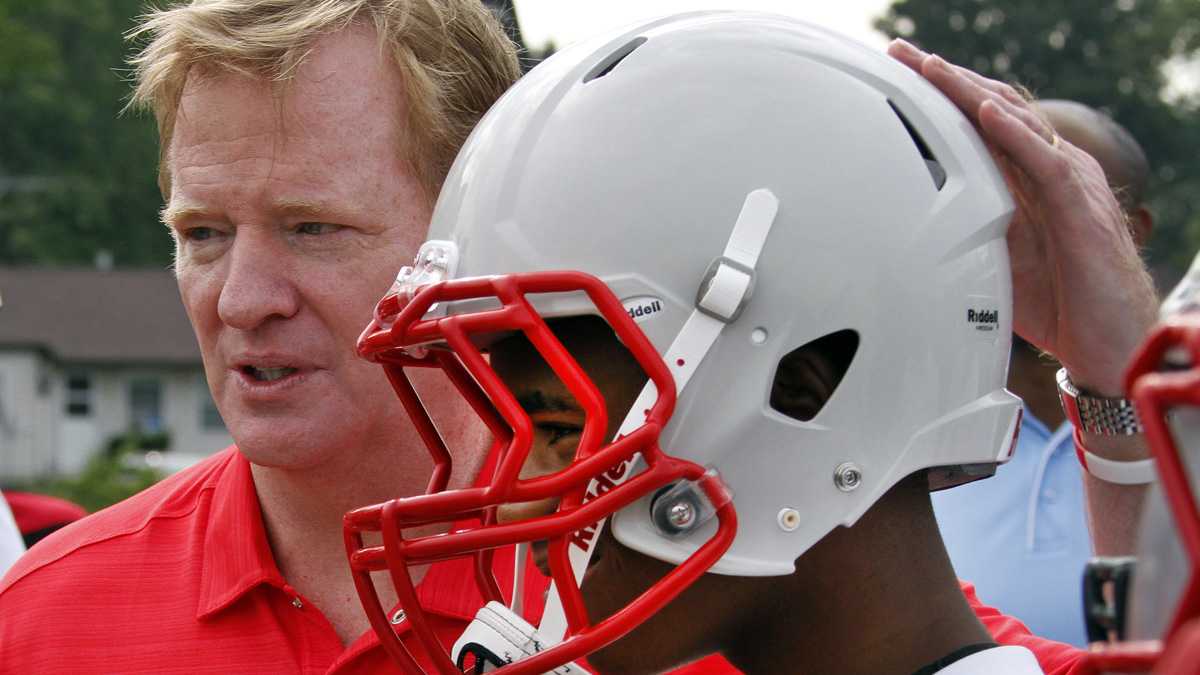Why helmets are no magic bullet for preventing concussions
Listen
(AP Photo
Do helmets really cut down on the risk of concussion? Recent research is not so encouraging.
It’s a glorious time to be a football fan.
The NFL playoffs are underway, the Super Bowl is just weeks away. The national rite of football gives so many people so many exciting moments. Maybe that’s why it can be hard to wrap one’s mind around one of the game’s huge downsides: what it may do to the brains of the young men who play it.
The spotlight on head injuries in sports, particularly football, has grown more intense in recent years. Last fall, the NFL settled for $765 million dollars in a class action lawsuit by former players over concussions, a case heard in Philadelphia.
Last week, a Mississippi father filed a federal class action suit on behalf of all student athletes asking the bodies governing college and high school sports to provide better and more uniform information on concussion risks.
Many of the sports Americans and young adults in particular love to play – not just football, but hockey, soccer and the rest – risk collisions and jolts to the head that can lead to concussions. Sometimes the signs are obvious, as was the case with Emily Panchak and Patrick Crowley, high school athletes in the Wilmington area.
“I didn’t get knocked out, but I was crying, and it hurt really bad,” says Panchak, who right after a head collision last spring, couldn’t remember the bus ride over to the soccer game that day.
“The way I landed, the way I hit the back of my head on the ground, it just riled me pretty bad,” recalls Patrick Crowley, Concord Raiders’ football captain, of a concussion that put him out of play for several weeks a few years ago.
Injuries can also be more subtle, cautions Rosemarie Scolaro Moser, a neuropsychologist who runs the Sports Concussion Center of New Jersey.
“The problem with a concussion is true symptoms often don’t show till hours or days later,” Moser recently told The Pulse. “And with youth, they’re more vulnerable to a second hit. So for example, if they haven’t fully recovered and they get hit again, that second hit, even if it might not have caused a concussion to begin with on its own, can cause serious damage.”
Searching for the magic bullet
Trying to change how games are played to avoid collisions has proven difficult and controversial. It has led to a search for the magic bullet, in hopes of sharply reducing the risk of concussion: better equipment. In football, this often means the helmet.
Some companies have marketed claims to young athletes their headgear could be the better mousetrap.
At Schuylkill Valley Sports in Easton, Pa., Mike Morris estimates two to three high school football players per team have come in to buy their own, more expensive, helmet this past season.
“They’re looking to get something better,” says Morris. “They’re just looking for something that will minimize the risk of concussion.”
But do any football helmets really cut down the risk of concussion? And are certain models worth the extra money?
What role do helmets play?
Halfway across the country, Alison Brooks had a similar experience to Mike Morris at Schuylkill Valley Sports. Brooks specializes in sports medicine at the University of Wisconsin. Parents and young athletes kept asking her which helmets they should get. Many were feeling pressure at school to buy newer ones.
So she designed a prospective study, observing over 1,000 high school football players last year who wore the three most common helmets, including some of the newest models. She parsed out the number of reported concussions based on helmet brand, model and age, to see if there was any big variation.
There wasn’t.
“You know as best we can tell they all adequately do what they were designed to do, which is prevent skull fractures, prevent intracranial bleeds, prevent superficial scalp and face injuries,” Brooks recently told The Pulse. “But there’s not any evidence that any one of them is particularly going to reduce your concussion risk.”
Brooks’ findings are preliminary, and may not account for other possible external factors. But the results don’t surprise Robb Rehberg, a concussion specialist and professor of athletic training at William Patterson University in New Jersey. Rehberg thinks some helmets are doing a better job at protecting the head and “attenuating the forces that typically cause concussion,” but while helmet design has improved a lot compared to ten years ago none can, nor should, claim to prevent a concussion.
Other research points to similar takeaways.
Evidence limited
In general, scientists don’t know how effective helmets are when it comes to concussions in kids ages 5 to 21.
Kristy Arbogast and Susan Margulies reviewed all the evidence to date for a recent Institute of Medicine Report: Sports-Related Concussions in Youth – Improving the Science, Changing the Culture. Margulies, a bioengineer at the University of Pennsylvania, says part of the challenge is the science behind concussions isn’t there yet. There’s no standard, objective way for actually identifying and reporting them.
“Evidence that a concussion has occurred is really entirely based on the athlete saying that I think I’ve had a head injury,” says Margulies.
So imagine trying to diagnose an ACL tear and come up with a rehab plan solely on the athlete’s description of knee pain rather than an MRI, where the actual injury can be objectively visualized. The IOM report points to another major challenge when it comes to identifying concussions: the culture of sports and pressure to hide injuries.
“Probably one of the most important things we stress to the kids is you have to be honest,” George Kasonovich recently told The Pulse.
Kasonovich, head football coach at Concord High School in Delaware, says schools have much better protocols nowadays, thanks to improved education, regulations and awareness regarding concussions. If one is even suspected on the field, a player’s out and can’t return without a physician’s note.
But Kasonovich’s mindset isn’t universal. And, athletes also face a lot of pressure to hide injuries. Seniors Patrick Crowley and Keyon Powell are Concord’s co-captains. Both have suffered from concussions in the past, and had to sit out for several weeks.
“Some of the worst people to talk to about that are your teammates and your friends because they’re always going to want you go out there no matter what you’re feeling,” says Crowley.
“It’s basically the pride of it, you don’t want to sit on the sideline, you always want to be out there helping your teammates,” says Powell.
It makes the job of the school’s athletic trainer, Scott Klabunde even trickier. He doesn’t joke around.
“I’m not going to lie, I’ve threatened them,” says Klabunde. “It was ‘hey, if you really screw this up, you could die.'”
Technology outpacing science
While helmets do protect against head injuries like skull fractures, relying on them to prevent concussions is problematic for another reason: the limitations in how helmets are assessed.
Arbogast, with the Children’s Hospital of Philadelphia, says helmet standards and effectiveness have historically been based on a drop test.
“They take a helmet, they put a humanoid head form – a plastic rubber head form in the helmet – and they drop it a given height and measure its acceleration,” says Arbogast. “And there are thresholds below which every helmet must meet.”
But in the real world you don’t always hit your head in a straight line that way. Arbogast and Margulies both say the manor and direction your head moves are big factors in developing a concussion.
“We know it’s a combination of linear movements along a straight line and rotational movements,” says Arbogast. “But we don’t know the specific level, the magnitude of those movements.”
“Nodding your head yes verses ‘I don’t know’ are two rotational motions,” says Margulies. “They could have very different risks associated with concussion.
Those concussion risks could also vary based on a kids’ age and individual experience. No one hit and reaction is alike. The science, they say, just hasn’t caught up with the product development.
“And so without that fundamental data we can’t really answer a question about whether a given helmet protects against concussion or not,” says Arbogast.
“Current helmets may mitigate rotational accelerations, but we’re not measuring it now,” Margulies adds.
For the recent IOM youth concussion report, Margulies and Arbogast also examined other kinds of protective equipment, like facial masks and mouth guards. They found no evidence those devices reduce concussion risk, though they are important when it comes to protecting against other kinds of injuries.
Their chapter notes that solely relying on helmets as a way to reduce concussions might have another unintended effect, a phenomenon called “risk compensation” which has been studied a lot in safety literature: “the athlete may be emboldened by the increased protection to take additional risks, thus mitigating any benefits of the protective device.”
More to preventing concussions
Despite helmet limitations, concussion specialists caution against relying only on that bit of equipment to prevent or lessen the risk of getting a concussion, anyway.
“The helmet isn’t all of the story here,” says Arbogast. “We need to understand how particular practice methods or aspects of the game might be able to be modified to protect the head.”
Arbogast says that includes teaching different tackling techniques, and developing strategies that go well beyond the playing field, in terms of education and following up for when a concussion occurs, to ensure a full a recovery.
WHYY is your source for fact-based, in-depth journalism and information. As a nonprofit organization, we rely on financial support from readers like you. Please give today.



